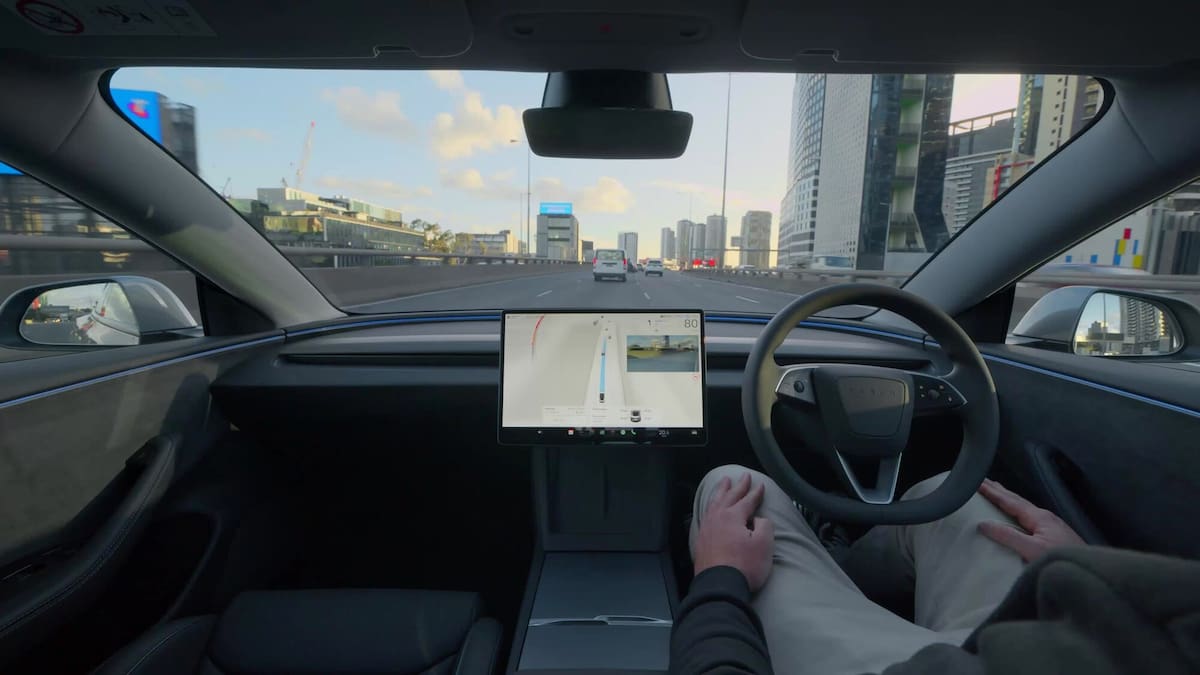That means you can’t be in the back seat with your feet up scrolling your iPad. You have to be at the wheel, with eyes on the road ready to take charge immediately if need be.
You don’t need to have “hover hands” over the steering wheel, but you do need to have your eyes on the road ahead and your hands near the steering while.
If an interior camera detects inattention, you get a series of escalating warnings followed by FSD being disabled.
The need for a driver behind the wheel also mean a couple of FSD features available to Americans – including the nifty “Summon” feature that sees a Tesla parked in the middle of a car park drive itself to where you’re standing on the edge – are not part of the package here.
Still, Lindsay Faithfull – owner of Northland firms McKay and Naut – tells the Herald he’s found FSD “seriously impressive”.
Faithfull has driven his Tesla between Whangārei and Auckland twice and says he’s only had one incident, near Ruakākā, where his car stayed on a passing lane crosshatch.
He was unsure if his vehicle would eventually shift into the left lane so took manual control. He was impressed that his Tesla asked him to leave a voice note on the incident, which was sent to the firm’s HQ to assist ongoing efforts to refine the system.
There was also a bit of a blooper the first time Faithfull enabled FSD (see the video above). He was wondering how his Tesla would handle “the tricky turn into our driveway” at the end of the trip.
But in the event, the vehicle – which was going purely by the street address – parked itself in a bus stop outside.
It was a harmless incident, with no traffic around, but tech commentator Paul Spain notes it’s one that could potentially cop a $150 driving-in-a-bus-lane fine.
‘Pretty convinced’
Driven reviewer Damien O’Carroll, who has been road-testing a new Tesla Model 3 with FSD enabled, was initially sceptical of Tesla’s move into a more advanced form of Level 2 autonomous assist.
“I had been far from impressed by earlier efforts that I found to be overly aggressive and not particularly accurate. And even more so since it abandoned all sensors in favour of a purely camera-based system.
“However, I have been deeply impressed by the new system and after driving it – well, being driven by it – for just over a week now, I am pretty convinced by it.”
AI learns from experience
While most other self-driving systems use Lidar (pulsed lasers) or other sensors, Tesla moved to an all-camera system over 2022 and 2023.
“There seems to be a fair bit of the heavy lifting being done by AI when it comes to its ability to take in what is happening around it,” O’Carroll says.
He says FSD has noticeably improved over the week as it’s become familiar with his common routes, such as from home to the office.
“It’s made a few minor mistakes, mainly related to road markings that, in fairness to the car, were quite confusing and indistinct,” he said.
“For example, it got totally flummoxed by the intersection of the road from the Chelsea Sugar Factory, the Highbury main street and Onewa Road, which I have seen many human drivers totally mess up, so I can’t blame it all that much.
“Subsequent passes through the same intersection have been faultless, so it learns from its mistakes, which is impressive.”
‘Mickey Mouse’ FSD
“One of the more amusing mistakes it has made was slowing slightly when it spotted a large child-sized statue of Mickey Mouse near a pedestrian crossing,” O’Carroll says.
“It either really likes Mickey Mouse, or thought it was a child getting ready to dart out on the crossing.”
‘Unmarked country roads with ease’
The Driven scribe also took his FSD-controlled Tesla on a 360km round trip down to Otorohanga.
“While I found letting the car do its thing on a smaller two-lane road with oncoming traffic a little unnerving, it handled it fine, even taking to narrow unmarked country roads with ease,” he says.
“It would noticeably keep further left when on an unmarked road too, which was interesting.”
‘Tad too cautious’
“The only thing that really bugged me about it on open roads – and occasionally on motorways- was its tendency to be a tad too cautious, often wandering along at 70km/h or 80km/h when it really didn’t need to,” O’Carroll adds.
“A quick prod on the throttle would get it back up to speed again, though.”
$10,000 paid and no FSD yet
FSD (Supervised) requires a new-ish Tesla.
One longtime superfan Ian McCrae, was disappointed the system requires a vehicle with the firm’s fourth-generation hardware, first released in January 2023 (and known as HW4 in Tesla-speak).
The Orion Health founder has a model with first-generation hardware.
Spain says he had paid for FSD outright when he bought his Tesla with HW3 in 2023.
“Many older Teslas with HW2.5 got upgraded to HW3,” he notes.
“It’s been indicated that HW3 cars in New Zealand and Australia will be catered to with FSD but Tesla has not confirmed a timeframe.”
“[Tesla CEO] Elon Musk has suggested they’ll get upgraded to HW4 at Tesla’s cost.”
Details have yet to be confirmed, however. The Herald has asked Tesla for comment.
For now, Spain is willing to give Tesla the benefit of the doubt it will deliver the FSD that he paid $10,000 for in 2023 – although he adds that before the FSD (Supervised) launch last month he had been mulling a complaint to the Disputes Tribunal.
Fund manager Lance Wiggs was also caught out by having a Tesla that pre-dated HW4.
But in his case, he hadn’t paid an extra $10,000 for FSD, having been unimpressed by Tesla’s Autopilot – a less fully-featured precursor to FSD – which he said, in his view, “Works well on motorways and straight roads, and is dangerously appalling in New Zealand’s twisty rural highways and roads.”
What about safety?
In October last year, the US National Highway Traffic Safety (NHTS) Administration opened an investigation into FSD’s performance in reduced visibility conditions caused by fog, dust or sun glare.
The investigation, which followed two fatalities, is ongoing.
The NHTS has recorded at least 70 crashes per month involving ADS (automated driving systems) across all brands in the first half of this year, with a high of 110 in May.
Musk – who targeted the NHTS during his time directing Doge, resulting in job cuts at the agency – has long argued that ADS systems cause fewer crashes per million miles driven compared to all vehicles.
Chris Keall is an Auckland-based member of the Herald’s business team. He joined the Herald in 2018 and is the technology editor and a senior business writer.





